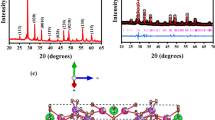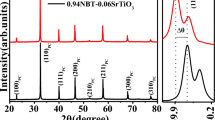Abstract
Thermoelectric polycrystalline ceramic materials were prepared by a new ceramic technology. Samples of p-type 72% Sb2Te3 + 25% Bi2Te3 + 3% Sb2Se3 doped with tellurium and 90% Bi2Te3 + 5% Sb2Te3 + 5% Sb2Se3 doped with Sbl3 or Agl were studied. The new ceramic cooling materials have an inhomogeneous structure, but higher mechanical strength and thermoelectric properties. The method is simpler than the Bridgman and powder metallurgy processes. Measurements of properties show that sintering temperature and time effect the thermoelectric properties of the samples. Scanning electron microscopy shows that the polycrystalline ceramic materials have an obvious layered structure. The doping of the materials was studied, including doping variety and doping concentration. The figure of merit for n-type doped with Sbl3 is 2.9 × 10−3 K−1, while that for p-type doped with tellurium is 3.1 × 10−1 K−1.
Similar content being viewed by others
References
GOLDSMIT and DOUGLAS (1954).
J. BLACK, E. CONWELL, L. SIEGLE and C. W. SPENCER, J. Phys. Chem. Solids 2 (1957) 240.
C. Y. LI, A. L. RUOFF and C. W. SPENCER, J. Appl. Phys. 32 (1961) 1733.
S. V. AIRAPATIANTA and B. A. EFFIMOVA, Sov. Phys. Tech. Phys. 2 (1959) 1932.
Author information
Authors and Affiliations
Rights and permissions
About this article
Cite this article
Wanqiu, C., Hao, C. Studies on the structure and properties of semiconductor ceramic cooling materials. J Mater Sci: Mater Electron 4, 305–308 (1993). https://doi.org/10.1007/BF00179229
Received:
Accepted:
Issue Date:
DOI: https://doi.org/10.1007/BF00179229




